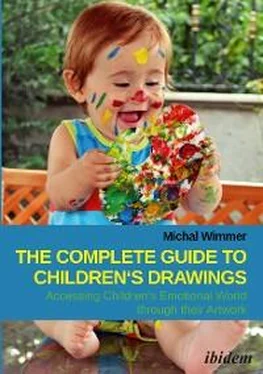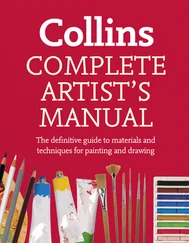Content
About the Author
Preface
1 Introduction
2 Colors
3 Family Relationships
4 Sibling Relationships
5 ADHD
6 Divorce
7 Transitions and Transformations
8 Social Functioning
9 The Human Body
10 Fears
11 Anxieties and Traumas
12 Cognitive Performance
Epilogue
References
Copyright
ibidem Press, Stuttgart
About the Author

Michal Wimmer, M.A, is an art therapist and an international expert on children’s drawings analysis. She has years of experience supporting families with children (aged 2–18) with emotional and social difficulties using their drawings. Michal is also the founder of an advanced studies program, introducing social workers, psychologists and art therapists, as well as elementary and preschool teachers to the world of children’s drawings analysis. The program includes a two-year graduate study on children’s drawings analysis, based on practical exercises, various psychological theories and parental guidance.
A popular speaker, Michal has given hundreds of workshops and keynotes about children’s drawings analysis in Universities, Colleges and private events. She is often interviewed in TV shows, magazines and newspapers for insights about parenting through children’s drawings. Michal manages a national forum about children’s drawings analysis, providing parental guidance based on drawings. Finally, she also provides written expertise to courts of law, based on analysis of children’s drawings, mainly in the context of family abuse and children at risk.
Michal runs a private clinic for treating children, adolescents and adults. She also works as an art therapist in psychiatric hospitals and mental health clinics. Recently, she has founded the Roshida website. Her therapeutic strategy is deeply influenced by the classic psychoanalytic approaches of Sigmund Freud and Jacques Lacan.
Preface
One of the most charming moments in parenting is when your child shares a new and fascinating discovery with you. Together with the child, you too are excited to see a tiny beetle resting on a green leaf, sand dunes that have instantly become giant slides, and an entire world of scents, tastes, colors and shapes we have all but forgotten over the years.
Children’s drawings reveal similar experiences. Each drawing is the starting point of a voyage led by the child explorer. In this book, you – educators, therapists and above all parents – are offered the opportunity to join this unique voyage and understand the child’s world from his distinct perspective.
Parenting in today’s world is far from straightforward. Parents who may be successful in other areas in their lives are often unconfident and even helpless when facing parenting tasks. The parental role involves dealing with fundamental questions, such as: Have I set the appropriate boundaries? Have I understood my child properly? Have I given him the right behavioral reinforcements? Have I correctly interpreted his signals? Today’s parents are anxious to understand their child and be more involved in his emotional world, so as to be able to provide the right answers when he’ll need them.
In this context, children’s drawings offer a kind of map enabling you to navigate in the child’s inner emotional world. Through the drawings, the child expresses his difficulties, as well as the solutions he requires. Informed observation of the child’s artwork may provide parents, therapists and educators with a reliable compass for understanding the child’s present needs.
My approach to interpreting children’s drawings and to diagnosing children in general is positive and optimistic. The drawings shed light on the child’s world, enabling us to understand his difficulties but also the strengths which enable him to grow towards solutions that are appropriate for his personality. All children want to develop and experience the world around them, but they require proper encouragement and guidance to support them on their way to realizing their potential. Interpreting children’s drawings enables the parent to avoid forcing standardized, one-size-fits-all solutions that have been offered to different families under different circumstances, and instead assess what is most appropriate for his child at a given moment in his life. Just as many children can have fever, but each for a different reason, children’s drawings allow us to better understand the various reasons for the same behavioral manifestation.
This book presents hundreds of fascinating examples of children’s drawings that I have collected from various places around the world. Most of these drawings have been made by children whose parents had been referred for emotional counseling and therapy, in the course of which multiple drawings have been analyzed. The conclusions presented next to the drawings are based on comparisons with other drawings by the same child in different periods of his life and on a personal interview with his parents, which add an important dimension to understanding the child’s world in the family system. Drawings selected to illustrate various phenomena usually include one manifestation of the given phenomenon (sometimes the most common and sometimes a particularly rare one). Naturally, every interpretation is based on recurring manifestations of the same phenomena, together with graphic indicators supporting my conclusions. Note that one may never reach any final conclusions based on a single feature in the drawing – such features are offered only as illustrations of broader phenomena.
The last few years were dedicated to a thorough research, which included reviewing findings of studies conducted in the best universities in the world as well as conducting my own groundbreaking studies on 100–300 children each in order to obtain statistically significant results. It is an honor and privilege to present the fruits of this labor to you, in this book. Throughout the book, I have sought to enable all readers to understand the significance of the various research findings and to integrate them with my professional knowledge and experience as an expressive art therapist.
I sincerely hope that the resulting book will enhance public awareness of how the child’s inner world is reflected in his drawings and open an additional channel of communication between the parent, educator or therapist on the one hand, and the child on the other – a channel that will enrich and reinforce their relationship.
Note: All drawings in this book have been published with both parents’ informed consent. Wherever necessary, identifying details of the child or family have been changed or removed.
Right after this page begins a magical and colorful journey in the world of children’s drawings. I hope the book will give you tools to gain a new perspective of your child’s drawings, your child’s world and even the child within you…
Michal Wimmer
1 Introduction
Developmental Stages in Children’s Drawings
When you observe a child’s drawings over an extended time period, you will notice trends of change and development. Without any deliberate adult intervention, the child advances from stage to stage and develops his abilities. Nevertheless, despite evidence of clear and general developmental stages, I do not recommend analyzing a child’s artwork in strict terms of how it matches a certain population norm. When I interpret a child’s drawings, I do not compare them to his friends’ drawings but to his own developmental trajectory. Therefore, the ages noted in the titles below are suggestive only and should be treated with caution.
Читать дальше













